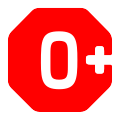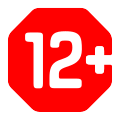On Protecting Children from Information Harmful to Their Health and Development
"On Protection of Children from Information Harmful to Their Health and Development" (Russian: О защите детей от информации, причиняющей вред их здоровью и развитию; Federal law of the Russian Federation no. 436-FZ of 2010-12-39)[1] is a federal law of the Russian Federation. It was enacted on 29 December 2010 as a content rating law. IntroductionAn amending law was enacted in July 2012. That law contained changes to other laws, introducing a "child-protecting" Internet blacklist not related to this law, so Russian Wikipedia protested the bill with a blackout. The law prohibits the distribution of "harmful" material among minors, including material which "may elicit fear, horror, or panic in children", or depicts violence, unlawful activities, substance abuse, or self-harm. It has been amended twice; an amendment in 2012 instituted a mandatory content rating system for material distributed through an "information and telecommunication network" (covering television and the internet), and, in other laws, established a blacklist for censoring websites which describe suicide, glorify illegal drugs, or contain child pornography.[2][3][4][5] A second amendment passed in 2013 added "propaganda" promoting "Non-traditional sexual relationships" as a class of harmful content under the law. Formation of the Soviet and Russian age restrictions systemDuring the Soviet period, there was a three-tier system of age restrictions, recorded in the permit issued to each film (domestic or foreign): For any audience (0); For any audience (except for special children's sessions) (6); for those over the age of 16. There was a measure of refusal to issue permits to the film, which implied not only political motives, but also moral and ethical. In the late 1990s and early 21st century, at the initiative of Goskino, the Russian Ministry of Culture, the Russian Ministry of Education, the Film Institute and public organizations, the system was revised. At first (by order of the Russian Ministry of Culture of March 5, 2001 No. 192) two more age ratings (12 and 18 years) were added, which is more in line with the international accepted practice (for example, ratings of the American Film Association). Then, in 2005,at the initiative of teachers and psychologists, another category (14 years) was added. The modern system of classification of information productsOn September 1, 2012, after the federal law on the protection of children from information harmful to their health and development came into force, the following age classification of information products was introduced in Russia. Information products for children under the age of six (0+)  Information products for children under the age of six may include information products containing information that does not harm the health and (or) development of children (including information products containing episodic non-naturalistic images justified by its genre and (or) plot or a description of physical and (or) mental violence (with the exception of sexual violence), provided that good triumphs over evil and expresses compassion for the victim of violence and (or) condemnation of violence). Information products for children over the age of six (6+)  Information products for children who have reached the age of six years old may include information products provided for in Article 7 of this Federal Law, as well as information products containing justified by its genre and (or) plot.
Information products for children over the age of twelve (12+)  Information products for children who have reached the age of twelve years old can be classified as information products provided for in Article 8 of this Federal Law, as well as information products containing justified by its genre and (or) plot:
Usually, popular TV shows or films have such an age limit, which children under 12 may not understand, or which may seem uninteresting to them. Information products for children over the age of sixteen (16+)  Information products for children who have reached the age of sixteen years old can be classified as information products provided for in Article 9 of this Federal Law, as well as information products containing justified by its genre and (or) plot:
Usually, popular TV shows or films have such an age limit, which children under 16 may not understand, or which may seem uninteresting to them. Also, TV shows such as music, game and talk shows, magazines and many documentaries shall conform to the provisions of that rating. Information prohibited for distribution to children (18+) 
Symbols for age information productsThe color and shape of the mark is not legally defined. According to the Roskomnadzor Recommendations, the color and font of the sign for print media should differ from the color and style of the main font. Accordingly, there may be various options - for example, in a round, square and multi-colored version.[6] The names of the classification may contain abbreviations "РСВР" - "Russian Age Rating System" and English: RARS - "Russian Age Rating System". See alsoWikisource has original text related to this article:
References
External links
|
Portal di Ensiklopedia Dunia













